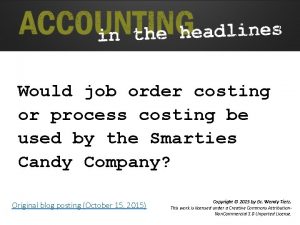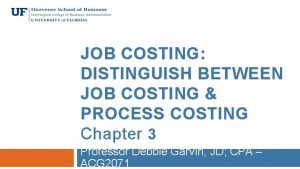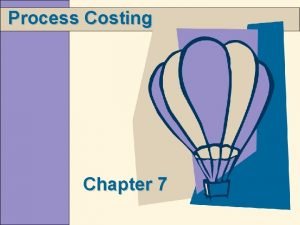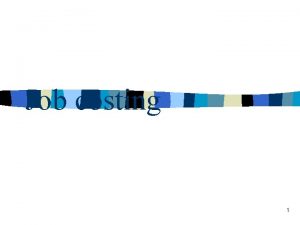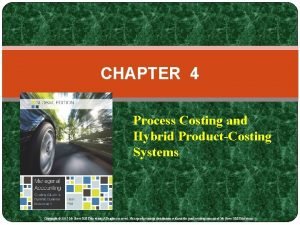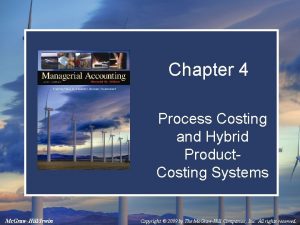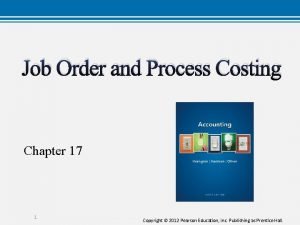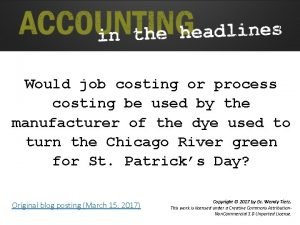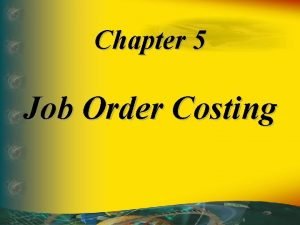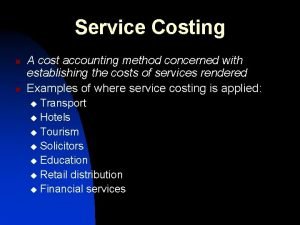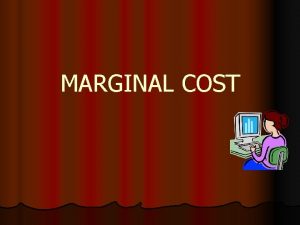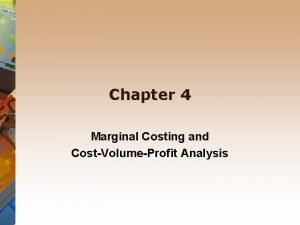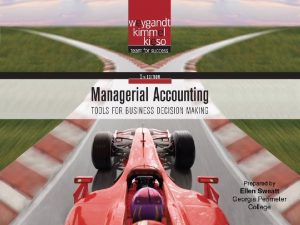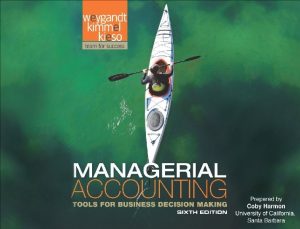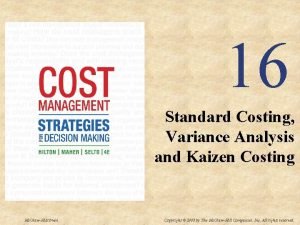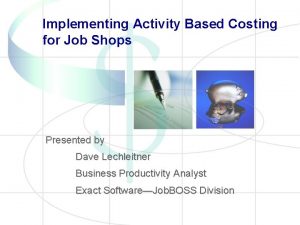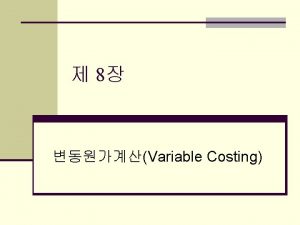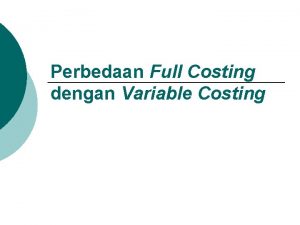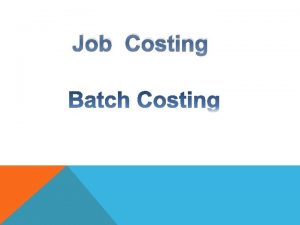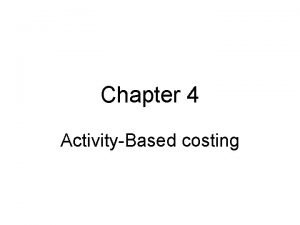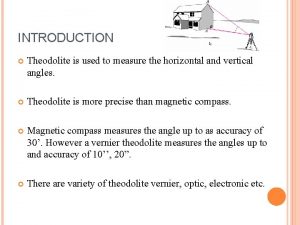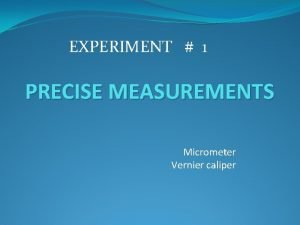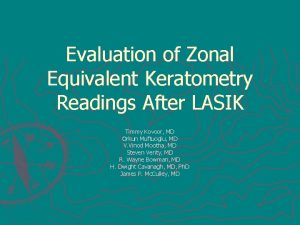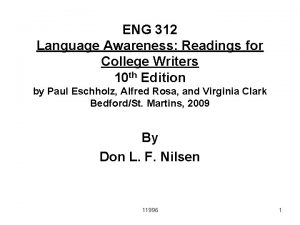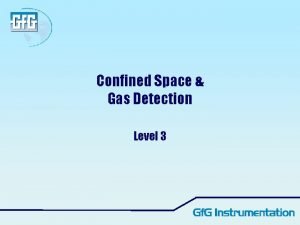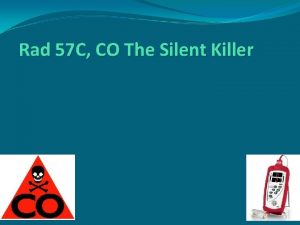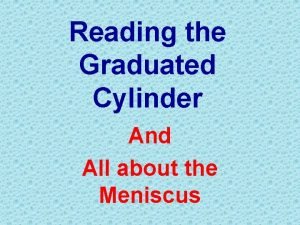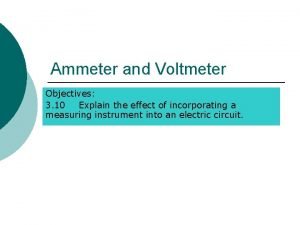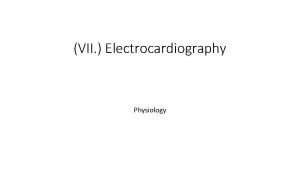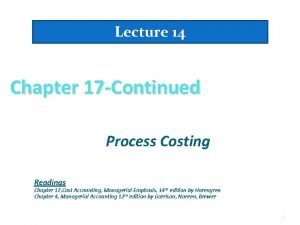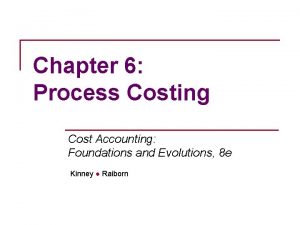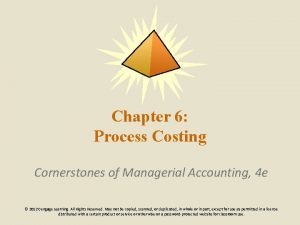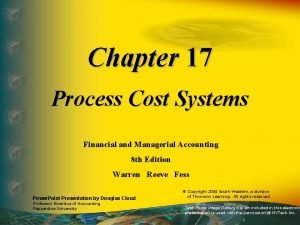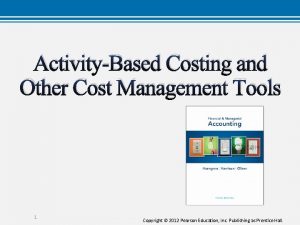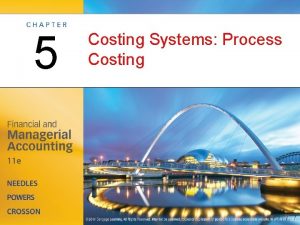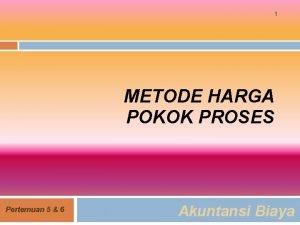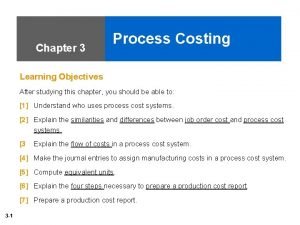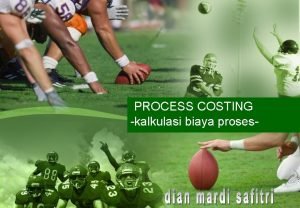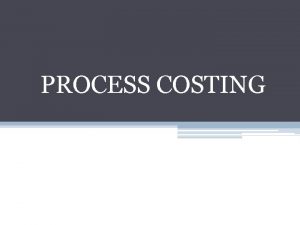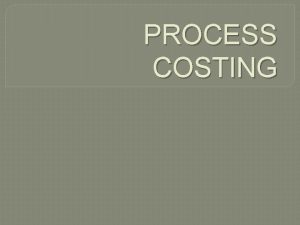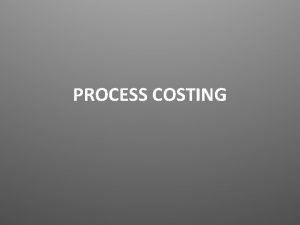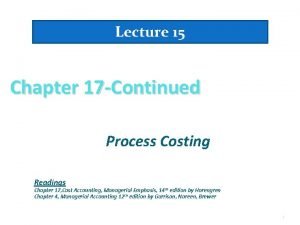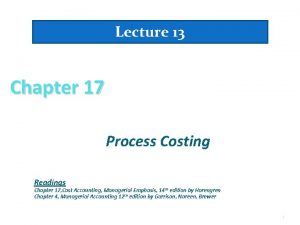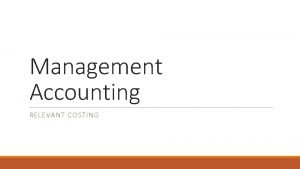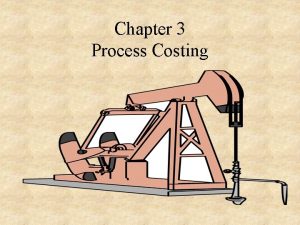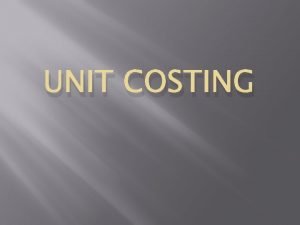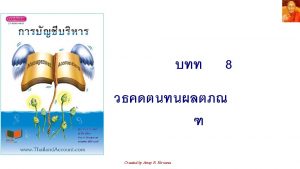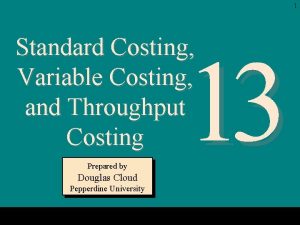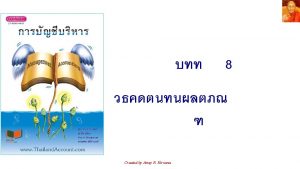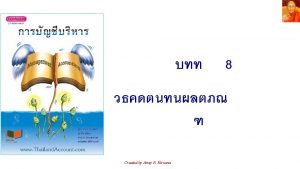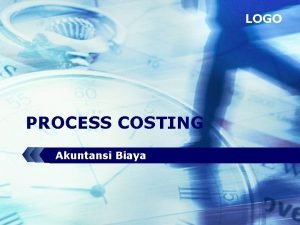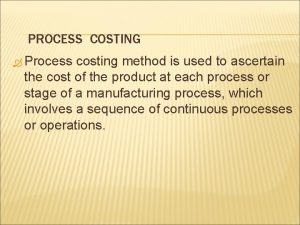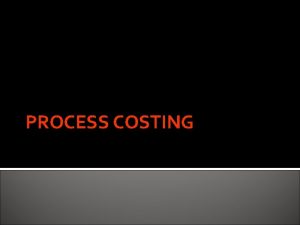Lecture 14 Chapter 17 Continued Process Costing Readings




















































- Slides: 52

Lecture 14 Chapter 17 -Continued Process Costing Readings Chapter 17, Cost Accounting, Managerial Emphasis, 14 th edition by Horengren Chapter 4, Managerial Accounting 12 th edition by Garrison, Noreen, Brewer 1

Learning Objectives Record the flow of materials, labor, and overhead through a process cost system. Compute the equivalent units of production using the weighted-average method. Compute the cost per equivalent unit using the weighted-average method. Assign costs to units using the weighted-average method. Compute the equivalent units of production using the FIFO method. Compute the cost per equivalent unit using the FIFO method. Assign costs to units using the FIFO method Allocate service department costs to operating departments using the direct method. To allocate service department costs to operating departments using the step-down method. 2

Equivalent Units of Production Equivalent units are the product of the number of partially completed units and the percentage completion of those units. We need to calculate equivalent units because a department usually has some partially completed units in its beginning and ending inventory. 3

Equivalent Units – The Basic Idea Two half completed products are equivalent to one completed product. + = 1 So, 10, 000 units 70% complete are equivalent to 7, 000 complete units. 4

Quick Check For the current period, Jones started 15, 000 units and completed 10, 000 units, leaving 5, 000 units in process 30 percent complete. How many equivalent units of production did Jones have for the period? a. 10, 000 b. 11, 500 c. 13, 500 d. 15, 000 5

Quick Check For the current period, Jones started 15, 000 units and completed 10, 000 units, leaving 5, 000 units in process 30 percent complete. How many equivalent units of production did Jones have for the period? a. 10, 000 units + (5, 000 units × 0. 30) b. 11, 500 = 11, 500 equivalent units c. 13, 500 d. 15, 000 6

Calculating Equivalent Units Equivalent units can be calculated two ways: The First-In, First-Out Method – FIFO is covered in the appendix to this chapter. The Weighted-Average Method – This method will be covered in the main portion of the chapter. 7

Equivalent Units of Production Weighted-Average Method The weighted-average method. . . • Makes no distinction between work done in prior or current periods. • Blends together units and costs from prior and current periods. • Determines equivalent units of production for a department by adding together the number of units transferred out plus the equivalent units in ending work in process inventory. 8

Treatment of Direct Labor Dollar Amount Direct Materials Direct Labor Direct labor costs may be small in comparison to Conversion other product costs in process cost systems. Type of Product Cost 9

Treatment of Direct Labor Dollar Amount Direct Materials Direct labor costs may be small Conversion in comparison to other product costs in process cost systems. Type of Product Cost Direct labor and manufacturing overhead may be combined into one product cost called conversion. 10

Weighted-Average Example Double Diamond Skis reported the following activity in Shaping and Milling Department for the month of May: 11

Weighted-Average Example The first step in calculating the equivalent units is to identify the units completed and transferred out of the Department in May (4, 800 units) 12

Weighted-Average Example The second step is to identify the equivalent units of production in ending work in process with respect to materials for the month (160 units) and add this to the 4, 800 units from step one. 13

Weighted-Average Example The third step is to identify the equivalent units of production in ending work in process with respect to conversion for the month (100 units) and add this to the 4, 800 units from step one. 14

Weighted-Average Example Equivalent units of production always equals: Units completed and transferred + Equivalent units remaining in work in process 15

Weighted-Average Example Materials Beginning Work in Process 200 Units 55% Complete 5, 000 Units Started 4, 800 Units Started and Completed 4, 800 Units Completed 160 Equivalent Units 4, 960 Equivalent units of production Ending Work in Process 400 Units 40% Complete 400 × 40% 16

Weighted-Average Example Conversion Beginning Work in Process 200 Units 30% Complete 5, 000 Units Started 4, 800 Units Started and Completed 4, 800 Units Completed 100 Equivalent Units 4, 900 Equivalent units of production Ending Work in Process 400 Units 25% Complete 400 × 25% 17

Compute and Apply Costs Beginning work in process: Materials: 55% complete Conversion: 30% complete 200 units $ 9, 600 5, 575 Production started during May Production completed during May 5, 000 units 4, 800 units Costs added to production in May Materials cost Conversion cost $ 368, 600 350, 900 Ending work in process Materials: 40% complete Conversion: 25% complete 400 units 18

Compute and Apply Costs The formula for computing the cost per equivalent unit is : Cost per equivalent = unit Cost of beginning work in process + Cost added during inventory the period Equivalent units of production 19

Compute and Apply Costs Here is a schedule with the cost and equivalent unit information. 20

Compute and Apply Costs Here is a schedule with the cost and equivalent unit information. $356, 475 ÷ 4, 900 units = $72. 75 $378, 200 ÷ 4, 960 = $76. 25 21

Applying Costs 22

Applying Costs 23

Applying Costs 24

Computing the Cost of Units Transferred Out 25

Computing the Cost of Units Transferred Out 26

Computing the Cost of Units Transferred Out 27

Reconciling Costs 28

Reconciling Costs 29

Operation Costing Operation cost is a hybrid of job-order and process costing because it possesses attributes of both approaches Operation costing is commonly used when batches of many different products pass through the same processing department. 30

FIFO vs. Weighted-Average Method The FIFO method (generally considered more accurate that the weighted-average method) differs from the weighted-average method in two ways: 1. The computation of equivalent units. 2. The way in which the costs of beginning inventory are treated in the cost reconciliation report. 31

Equivalent Units – FIFO Method Let’s revisit the Double Diamond Skis example. Assume the following activity is reported in Shaping and Milling Department for May: 32

Equivalent Units – FIFO Method Step 1: 1 Determine equivalent units needed to complete beginning inventory. 33

Equivalent Units – FIFO Method Step 2: 2 Determine units started and completed during the period. 34

Equivalent Units – FIFO Method Step 3: 3 Add the equivalent units in ending working in process inventory. 35

FIFO Example Materials Beginning Work in Process 200 Units 55% Complete 200 × 45% 5, 000 Units Started 4, 600 Units Started and Completed 90 Equivalent Units 4, 600 Units Completed 160 Equivalent Units 4, 850 Equivalent units of production Ending Work in Process 400 Units 40% Complete 400 × 40% 36

FIFO Example Conversion Beginning Work in Process 200 Units 30% Complete 200 × 70% 5, 000 Units Started 4, 600 Units Started and Completed 140 Equivalent Units 4, 600 Units Completed 100 Equivalent Units 4, 840 Equivalent units of production Ending Work in Process 400 Units 25% Complete 400 × 25% 37

Equivalent Units: Weighted Average vs. FIFO As shown below, the equivalent units in beginning inventory are subtracted from the equivalent units of production per the weightedaverage method to obtain the equivalent units of production under the FIFO method. 38

Cost per Equivalent Unit - FIFO Let’s revisit the Double Diamond Skis Shaping and Milling Department for the Month of May to prepare our production report. Beginning work in process: Materials: 55% complete Conversion: 30% complete Production started during May Production completed during May 200 units $ 9, 600 5, 575 $15, 175 5, 000 units 4, 800 units Costs added to production in May Materials cost $ 368, 600 Conversion cost 350, 900 Ending work in process: 400 units Materials: 40% complete Conversion: 25% complete 39

Cost per Equivalent Unit - FIFO The formula for computing the cost per equivalent unit under FIFO method is : Cost per equivalent = unit Cost added during the period Equivalent units of production 40

Cost per Equivalent Unit - FIFO 41

Applying Costs - FIFO Step 1: 1 Record the equivalent units of production in ending work in process inventory. 42

Applying Costs - FIFO Step 2: 2 Record the cost per equivalent unit. 43

Applying Costs - FIFO Step 3: 3 Compute the cost of ending work in process inventory. 44

Cost of Units Transferred Out Step 1: 1 Record the cost in beginning work in process inventory. 45

Cost of Units Transferred Out Step 2: 2 Compute the cost to complete the units in beginning work in process inventory. 46

Cost of Units Transferred Out Step 3: 3 Compute the cost of units started and completed this period. 47

Cost of Units Transferred Out Step 4: 4 Compute the total cost of units transferred out. 48

Reconciling Costs 49

Reconciling Costs 50

A Comparison of Costing Methods In a lean production environment, FIFO and weighted-average methods yield similar unit costs. When considering cost control, FIFO is superior to weighted-average because it does not mix costs of the current period with costs of the prior period. 51

End of Lecture 14 52
 Job order costing vs process costing
Job order costing vs process costing Both job order costing and process costing
Both job order costing and process costing Job costing definition
Job costing definition Differentiate between job costing and process costing
Differentiate between job costing and process costing Job order vs process costing
Job order vs process costing Process costing and hybrid product-costing systems
Process costing and hybrid product-costing systems Process costing and hybrid product-costing systems
Process costing and hybrid product-costing systems Process costing and hybrid product-costing systems
Process costing and hybrid product-costing systems Cost of production report example
Cost of production report example Job cost record
Job cost record Job costing with process costing
Job costing with process costing Job order cost accounting
Job order cost accounting Difference between service costing and output costing
Difference between service costing and output costing Marginal costing meaning
Marginal costing meaning Difference between job costing and contract costing
Difference between job costing and contract costing Variable costing vs absorption costing
Variable costing vs absorption costing How to calculate margin of safety
How to calculate margin of safety Activity based costing formula
Activity based costing formula Abc costing vs traditional costing
Abc costing vs traditional costing Kaizen costing vs standard costing
Kaizen costing vs standard costing Activity based costing vs job costing
Activity based costing vs job costing Mixed cost
Mixed cost Perbedaan full costing dan variable costing
Perbedaan full costing dan variable costing Job costing vs batch costing
Job costing vs batch costing Chapter 4 activity-based costing solutions
Chapter 4 activity-based costing solutions Standard costing
Standard costing Contoh full costing dan variable costing
Contoh full costing dan variable costing 01:640:244 lecture notes - lecture 15: plat, idah, farad
01:640:244 lecture notes - lecture 15: plat, idah, farad Types of readers
Types of readers How to take readings in theodolite
How to take readings in theodolite Msr and vsr
Msr and vsr Keratometer readings
Keratometer readings Language awareness readings for college writers
Language awareness readings for college writers Confined space gas limits
Confined space gas limits Rad 57 co readings
Rad 57 co readings Abg normal values
Abg normal values Practice reading graduated cylinders
Practice reading graduated cylinders Eb = p x a x t
Eb = p x a x t Responsive readings for christmas
Responsive readings for christmas Responsive reading for thanksgiving
Responsive reading for thanksgiving Jcu readings
Jcu readings Ammeter reading
Ammeter reading Normal ecg readings
Normal ecg readings Equivalent units fifo and weighted average
Equivalent units fifo and weighted average Eup cost accounting
Eup cost accounting Chapter 8 section 3 cellular respiration
Chapter 8 section 3 cellular respiration Process costing problems and solutions doc
Process costing problems and solutions doc Process costing
Process costing Process costing
Process costing Process costing
Process costing Penambahan bahan pada departemen lanjutan
Penambahan bahan pada departemen lanjutan Job costing objectives
Job costing objectives Contoh kalkulasi biaya proses
Contoh kalkulasi biaya proses
